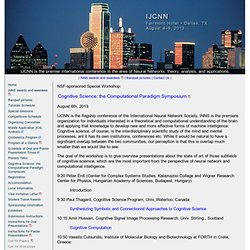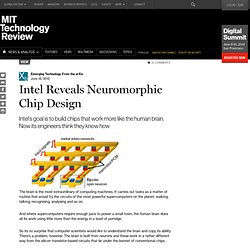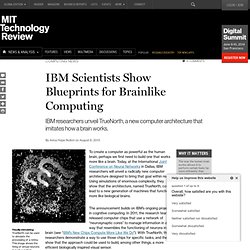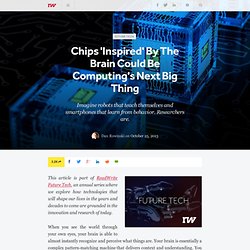

A research blog by Ashwin Ram, PhD. Dharmendra Modha - IBM Research. Dharmendra S.

Modha IBM Fellow; Chief Scientist - Brain-inspired ComputingSenior Manager - Cognitive Computing; IBM Research - Almaden Dr. Dharmendra Modha is the founder of IBM’s Cognitive Computing group at IBM Research – Almaden and the principal investigator for DARPA SyNAPSE team globally. In this role, Dr. In 2009, his group performed cortical simulations at scale of cat cerebral cortex (one billion neurons, 10 trillion synapses) on a BlueGene/P supercomputer. In 2010, his group compiled, visualized, and analyzed the largest long-distance network currently in existence of the Macaque monkey brain. In 2011, his team demonstrated two path-breaking neurosynaptic cores that move beyond von Neumann computers and programming to ultra-low, super-dense brain-inspired cognitive computing chips.
At IBM, he has won the Pat Goldberg Memorial Best Paper award twice, an Outstanding Innovation Award, an Outstanding Technical Achievement Award, and Communication Systems Best Paper Award. Dr. Dr. Dharmendra S Modha's Cognitive Computing Blog. Brains in Silicon. Cognitive Science: the Computational Paradigm Symposium – IJCNN 2013 – International Joint Conference on Neural Networks. NSF-sponsored Special Workshop: August 6th, 2013 IJCNN is the flagship conference of the International Neural Network Society.

INNS is the premiere organization for individuals interested in a theoretical and computational understanding of the brain and applying that knowledge to develop new and more effective forms of machine intelligence. Cognitive science, of course, is the interdisciplinary scientific study of the mind and mental processes, ant it has its own institutions, conferences etc. Building artificial nervous systems. Eugene M. Izhikevich old (NSI) home page. [1206.3227] Proposal For Neuromorphic Hardware Using Spin Devices. Intel Reveals Neuromorphic Chip Design. The brain is the most extraordinary of computing machines.

It carries out tasks as a matter of routine that would fry the circuits of the most powerful supercomputers on the planet: walking, talking, recognising, analysing and so on. And where supercomputers require enough juice to power a small town, the human brain does all its work using little more than the energy in a bowl of porridge. So its no surprise that computer scientists would like to understand the brain and copy its ability. There’s a problem, however. The brain is built from neurons and these work in a rather different way from the silicon transistor-based circuits that lie under the bonnet of conventional chips. Of course, computer scientists can simulate the behaviour of neurons and how they link together on conventional computers.
So the race is on to develop a different kind of chip that more accurately mimics the way the brain works. Brains in Silicon. Welcome to Brains in Silicon.
Learn about the lab, get to know the brains that work here, and find out about new projects that you could join. We have crafted two complementary objectives: To use existing knowledge of brain function in designing an affordable supercomputer—one that can itself serve as a tool to investigate brain function—feeding back and contributing to a fundamental, biological understanding of how the brain works. We model brains using an approach far more efficient than software simulation: We emulate the flow of ions directly with the flow of electrons—don't worry, on the outside it looks just like software. Building a Brain on a Silicon Chip. An international team of scientists in Europe has created a silicon chip designed to function like a human brain.
With 200,000 neurons linked up by 50 million synaptic connections, the chip is able to mimic the brain’s ability to learn more closely than any other machine. Although the chip has a fraction of the number of neurons or connections found in a brain, its design allows it to be scaled up, says Karlheinz Meier , a physicist at Heidelberg University, in Germany, who has coordinated the Fast Analog Computing with Emergent Transient States project, or FACETS . The hope is that recreating the structure of the brain in computer form may help to further our understanding of how to develop massively parallel, powerful new computers, says Meier. Karlheinz Meier. CICC. IBM's New Chips Compute More Like We Do - Page 2. A microchip with about as much brain power as a garden worm might not seem very impressive, compared with the blindingly fast chips in modern personal computers.

But a new microchip made by researchers at IBM represents a landmark. Unlike an ordinary chip, it mimics the functioning of a biological brain—a feat that could open new possibilities in computation. Inside the brain, information is processed in parallel, and computation and memory are entwined. Each neuron is connected to many others, and the strength of these connections changes constantly as the brain learns. Cognitive Science: the Computational Paradigm Symposium – IJCNN 2013 – International Joint Conference on Neural Networks. IBM Scientists Show Blueprints for Brainlike Computing. To create a computer as powerful as the human brain, perhaps we first need to build one that works more like a brain.

Today, at the International Joint Conference on Neural Networks in Dallas, IBM researchers will unveil a radically new computer architecture designed to bring that goal within reach. Using simulations of enormous complexity, they show that the architecture, named TrueNorth, could lead to a new generation of machines that function more like biological brains. The announcement builds on IBM’s ongoing projects in cognitive computing. Building artificial nervous systems. Introducing Qualcomm Zeroth Processors: Brain-Inspired Computing. Qualcomm’s technologies are designed from the ground-up with speed and power efficiency in mind. This way, devices that use our products can run smoothly and maximize battery life driven experiences.
As mobile computing becomes increasingly pervasive, so do our expectations of the devices we use and interact with in our everyday lives. We want these devices to be smarter, anticipate our needs, and share our perception of the world so we can interact with them more naturally. The computational complexity of achieving these goals using traditional computing architectures is quite challenging, particularly in a power- and size-constrained environment vs. in the cloud and using supercomputers.
For the past few years our Research and Development teams have been working on a new computer architecture that breaks the traditional mold. We have three main goals for Qualcomm Zeroth processors: 1. 2. Neuro-Inspired Chips for Robots and Smartphones. The world’s largest smartphone chipmaker, Qualcomm, says it is ready to start helping partners manufacture a radically different kind of a chip—one that mimics the neural structures and processing methods found in the brain.
The approach is emerging as a way to enable machines to perform complex tasks while consuming far less power. Chips 'Inspired' By The Brain Could Be Computing's Next Big Thing. This article is part of ReadWrite Future Tech, an annual series where we explore how technologies that will shape our lives in the years and decades to come are grounded in the innovation and research of today.

When you see the world through your own eyes, your brain is able to almost instantly recognize and perceive what things are. Your brain is essentially a complex pattern-matching machine that delivers context and understanding. You see a person, recognize their height, facial features, clothing and voice and your brain says, “Hey, that’s Bob and I know him.” A computer’s "brain" can't do this. It can see the same objects in life and may eventually be able to tell you what they are, but it does this by matching a digital representation of the objects it "sees" to similar representations stored in databases, using pre-defined instructions built into its code. Microsoft PowerPoint - IBM MRC presentation - Big Data and Congnitive Computing v9.pptx - IBM_MRC_presentation_-_Big_Data_and_Congnitive_Computing_v9.pdf.
MIT Computational Cognitive Science Group. The Future of Cognitive Computing. ICNC_COG.pdf. IJCNN2013.corelet-language.pdf. Cognitive computing. Cognitive Computing: The SyNAPSE Project. Cognitive Computing: - cognitivecomputing07.pdf. Cognitive Computing: - cognitivecomputing07.pdf. A research blog by Ashwin Ram, PhD. What Watson tell us about Cognitive Computing. A new software ecosystem for cognitive systems. A new software ecosystem for cognitive systems.